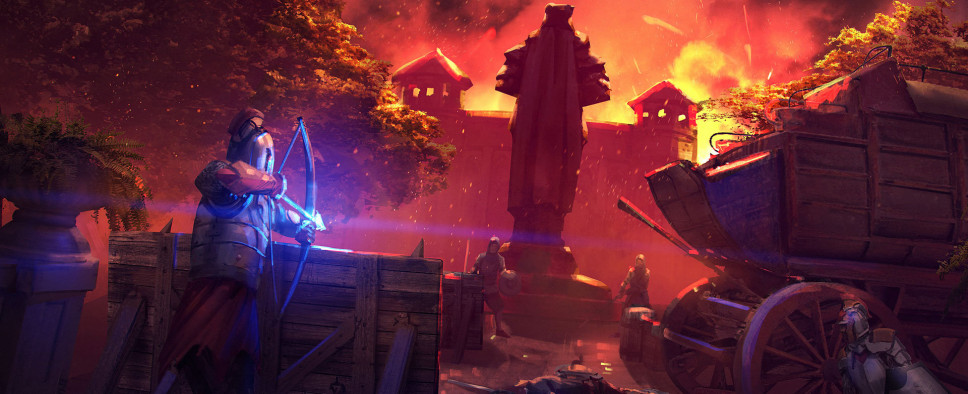Forged of Blood 2017 Wrap-up and Personality System
-
Category: News ArchiveHits: 1655

Forged of Blood, the upcoming tactical RPG from Critical Forge promises to be set in a world of grays and unique perspectives, and to show us that it's not just a marketing spiel, the latest post on the game's developer blog describes in great detail the Tri-Axis Philosophical Index that will replace the traditional Good vs. Evil dynamic in Forged of Blood.
Based around the philosophies of altruism, hedonism, and rationalism, Forged of Blood's Philosophical Index will put you into a pie chart of conflicting ideas and use geometry to determine how others judge your actions, offering a fresh take on a morality system in a video game. Here's how it will work:
Hey guys,
The studio will be going on break for the winter holidays but with the updates we just rolled out on the front page I thought we’d take some time to talk a little bit more about the Tri-Axis Philosophical Index we have for Forged of Blood.
The last time we talked about the personality system we touched more on the inspiration of the system. To recap: we really wanted to create a system that reflects the “grey” nature of our world and goes the beyond the usual binaries of good vs. evil, light vs. dark, etc. With our focus on choice and consequence, we also felt that it was important that the system have some very real consequences for the player beyond simply being a narrative tool for my whims. So we’d like to take this time to show a bit more of what the system actually entails.
In its current iteration the personality system is divided by three “philosophies” as opposed to “personalities” as to give the fairest interpretation between the three axes that the player will be measured against – and to try our best in removing overtly positive or negative connotations. Lorewise, the three philosophies represent three schools of thought that have shaped the world and upon which the denizens of Attiras are judged.
Altruism, Hedonism, and Rationalism make up the three axes of the circular index in which players will be plotted. The player, every playable character, Leivan (the brother King) and every conquerable region will have their own Philosophical Plot Point (PPP) that may shift throughout the duration of the game through direct and indirect player actions. With player’s parties and decisions acting as the unequivocal representative of the crown, Tavias’ plot point will act as the central point against which all decisions and consequences will be measured. Around this plot point is drawn what we call the: Philosophical Distance Threshold (PDT), which is a radius drawn around Tavias’ PPP that will denote the moral latitude that the different characters will accept. This plotted point will shift according to the player’s actions as they complete quests and advance the storyline.
This is where the mechanics of the system gets a bit more interesting to us. Playable characters within the radius will remain loyal to the player and be available for use in their parties, while captured regions within this radius will be loyal to your faction and slowly move their PPP towards the player’s over time. Conversely, characters that go beyond the player PDT will leave the player’s faction permanently and regions will have a percentage chance to rebel against the player’s control as time passes. Throughout the duration of the game, the player’s primary goal (aside from the chasing down quests) will be to retake territories throughout the world. As mentioned before, conquered regions will slowly shift their PPP towards Tavias’ PPP as time passes in the game. This leads up to the end-game in which the regional PPPs relative to the player’s will determine the player’s fate in the world.
So how does this all translate into the game loop? While the tactical combat and character progression systems remain core to our game, the added layer of the Tri-Axis Philosophical Index bring in some political choices and management to the non-combat related sections of the game. Your characters and soldiers are key to winning in battle – but if your choices pushes them beyond your PDT then you will quickly lose your effective fighting force. On top of that is the emphasis of the Philosophies’ impact on the world at large. Regions – controlled by a regional lord will have their own PPP like we mentioned, but doing a quest that gets the lord killed or replaced will give an entirely new PPP for that region, and this may or may not work in the player’s favor.
The endgame comes down to how many regions are in “favor” with the player’s PPP – calculated simply by distance between the three Faction PPPs. So while conquering regions is important, managing your PPP – and thereby the consequences of your actions – is key to effectively win the final end-game conditions. I won’t give away anymore than that as we do have a few things planned for the storylines that work in tandem with this mechanic, but I hope that does help paint a better picture as to the system we’re building out.

